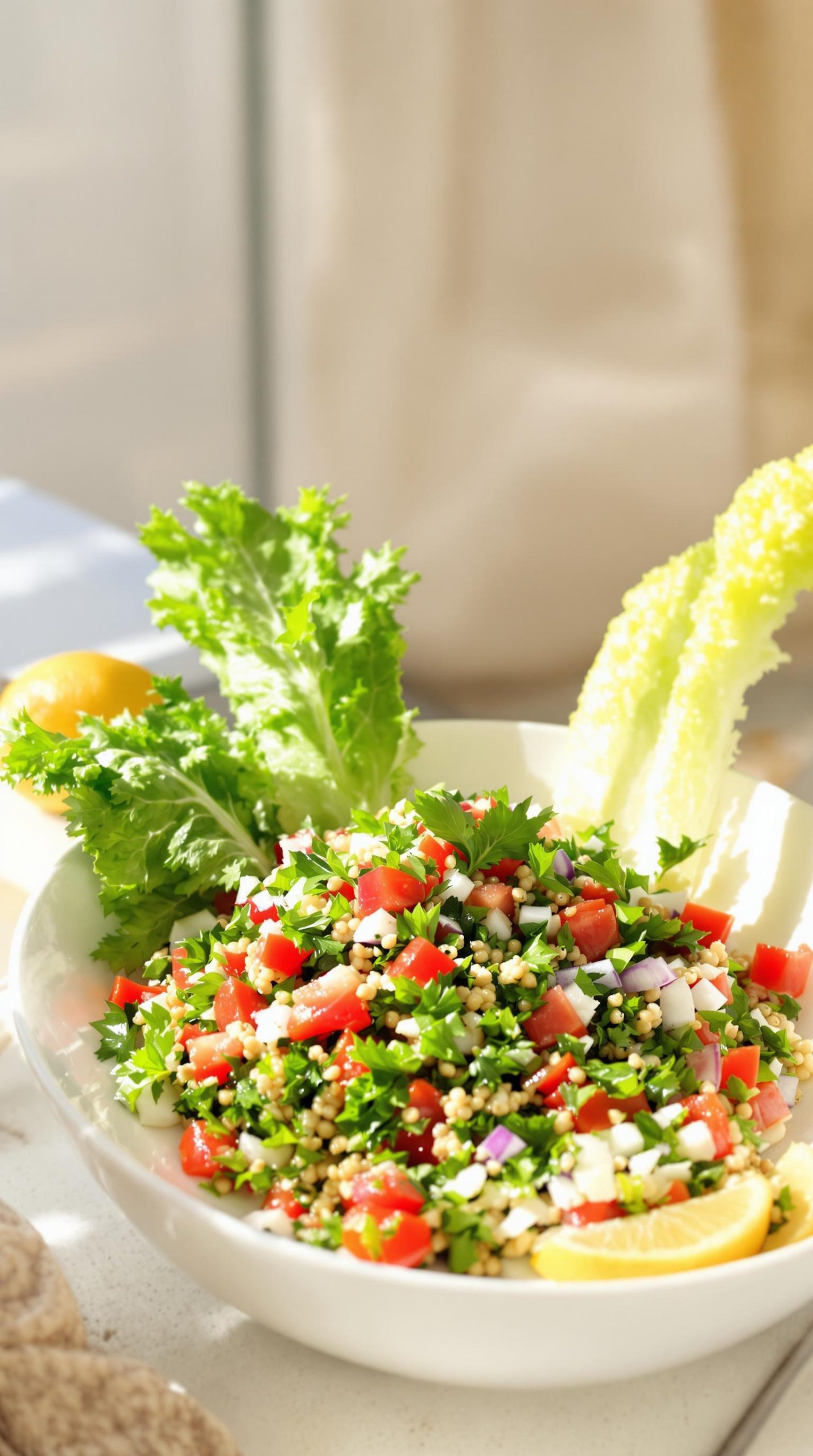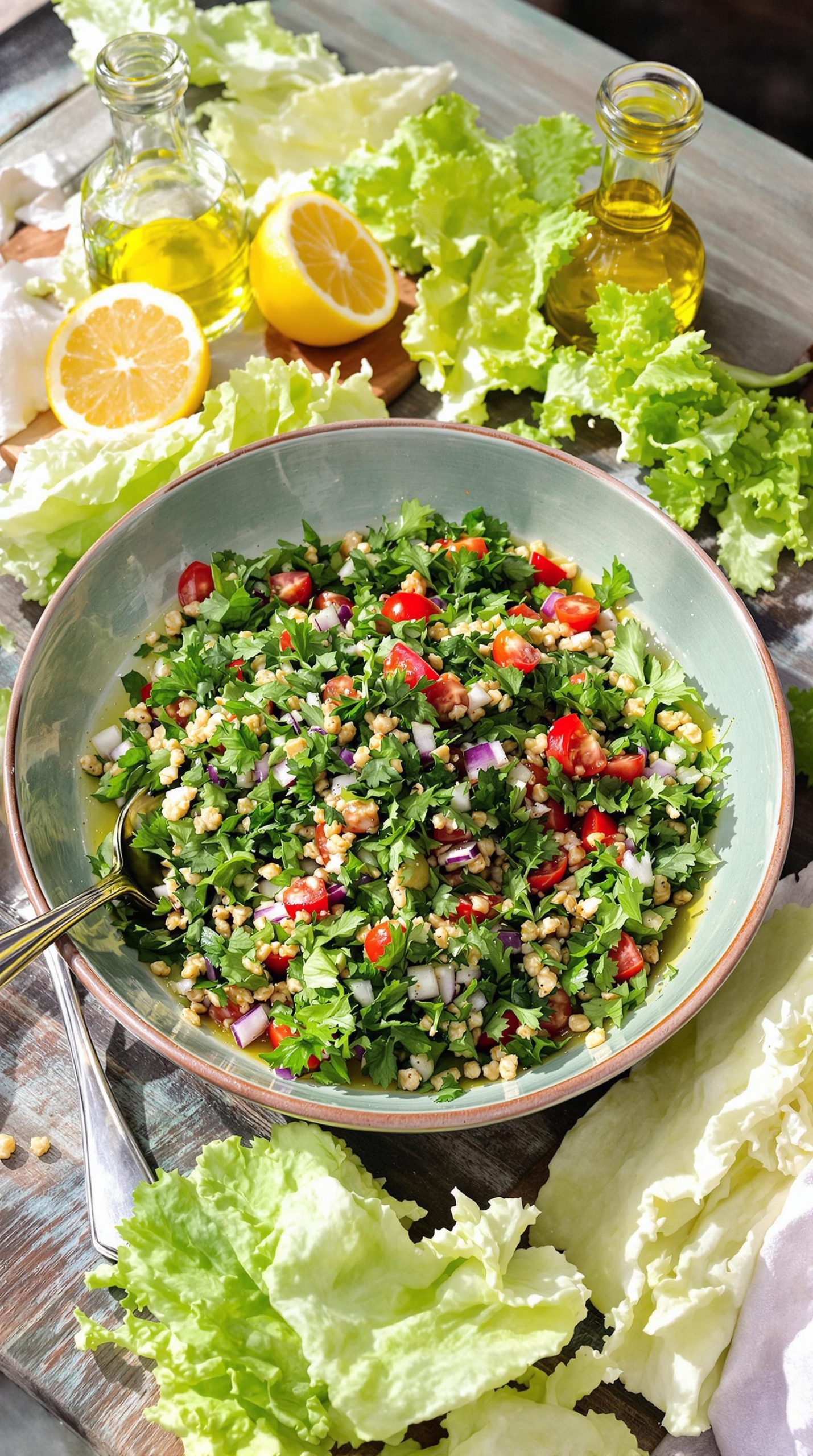Why You’ll Love this Mediterranean Tabbouleh
Almost everyone who tries this Mediterranean tabbouleh falls in love with its vibrant flavors and revitalizing qualities.
I’m convinced it’s the perfect balance of fresh herbs, tangy lemon, and nutty bulgur that makes it irresistible.
What’s not to love? It’s incredibly nutritious, featuring parsley and mint as the stars—not just garnishes.
The fine bulgur adds just enough texture without overwhelming the delicate herbs.
And that lemon juice? It brightens everything with a zesty punch that makes your taste buds dance.
Plus, it’s adaptable.
Need less salt? Want more tomato? The recipe bends to your preferences.
What Ingredients are in Mediterranean Tabbouleh?
The heart of any great tabbouleh is the perfect balance of fresh, vibrant ingredients that come together to create a symphony of flavors.
Traditional Mediterranean tabbouleh relies heavily on fresh herbs rather than grains, making it a revitalizing salad that’s both light and satisfying. The ingredients work harmoniously – the parsley and mint provide a fresh base, while tomatoes add juicy sweetness, and the bulgur contributes just enough texture to make it substantial.
- 1/4 cup fine bulgur wheat (uncooked)
- 2 cups finely chopped fresh parsley
- 1 pound firm tomatoes, finely chopped
- 1/2 cup finely chopped fresh mint leaves
- 1/4 cup finely chopped onion
- 1/2 cup lemon juice
- 1 teaspoon salt (or to taste)
- 1/2 cup extra virgin olive oil
- Crisp lettuce leaves or fresh cabbage leaves (for serving)
When shopping for these ingredients, quality matters tremendously.
Look for the freshest herbs you can find—they’re the real stars of this dish, not just garnishes. The tomatoes should be firm and ripe, as they’ll release juices that help soften the bulgur.
While the recipe calls for specific amounts of lemon juice, oil, and salt, feel free to adjust these to your personal taste. Many people, myself included, find they can reduce these quantities quite a bit while still maintaining the authentic flavor profile of this classic Mediterranean salad.
How to Make this Mediterranean Tabbouleh

Making tabbouleh is wonderfully straightforward, with the focus being on proper preparation of the fresh ingredients rather than complicated techniques.
Start by washing 1/4 cup of bulgur several times until the water runs clear, then drain it well. Instead of cooking the bulgur, you’ll simply soak it with the 1 pound of finely chopped tomatoes for about 20 minutes—this clever step allows the natural juices from the tomatoes to soften the bulgur while infusing it with flavor.
Meanwhile, wash your 2 cups of finely chopped parsley and 1/2 cup of mint leaves thoroughly, then make sure to drain them well (nobody wants a watery tabbouleh, trust me).
Next, take your 1/4 cup of finely chopped onion and rub it with some of the 1 teaspoon of salt. This little trick helps to mellow the raw onion’s bite and draw out some moisture.
Now comes the satisfying part—combine all your prepared ingredients in a large bowl, adding 1/2 cup of extra virgin olive oil and 1/2 cup of lemon juice. Toss everything together thoroughly, making sure the dressing coats every element evenly.
The beauty of tabbouleh is that you can absolutely adjust the amounts of oil, lemon juice, and salt to your preference—many home cooks (myself included) often reduce these quantities for a lighter version that still captures the authentic flavor profile. For easy preparation, consider using an efficient Korean kitchen set that includes sharp knives and precision cutting boards for the fine chopping this recipe requires.
Serve your vibrant tabbouleh with crisp lettuce leaves or fresh cabbage leaves on the side. These aren’t just for decoration; they’re actually the traditional way to enjoy this salad. Scoop up portions of the tabbouleh using the leaves as edible utensils—it’s a delightfully interactive way to enjoy this invigorating dish.
For a completely different dining experience, you could also serve this fresh Mediterranean salad alongside grilled meats cooked on a premium Korean BBQ grill for an exciting fusion meal.
Want to know the secret to truly great tabbouleh? Let it sit for about 30 minutes before serving, allowing all those Mediterranean flavors to mingle and develop. Just enough time to pour yourself a glass of something cold and set the table, don’t you think?
Mediterranean Tabbouleh Substitutions and Variations
Many traditional tabbouleh recipes offer room for creative adaptation without losing the essence of this bright Mediterranean salad.
I’ve found quinoa makes an excellent gluten-free alternative to bulgur, while cauliflower rice works beautifully for grain-free diets. Not a mint fan? Try fresh dill or cilantro instead.
For protein-packed variations, consider adding chickpeas, feta cheese, or even diced chicken.
Sometimes I swap cucumber for tomatoes when they’re not in season. Red onion can replace white for a sharper flavor, or try green onions for something milder.
And if you’re short on lemons, apple cider vinegar provides a similar tang.
What to Serve with Mediterranean Tabbouleh
Now that you’ve mastered the basic tabbouleh recipe and its many variations, let’s talk about what pairs perfectly with this vibrant salad.
I love serving tabbouleh alongside grilled proteins like lamb kebabs, chicken shawarma, or falafel for vegetarian options. It’s also divine with warm pita bread and creamy hummus or baba ganoush.
Can you imagine a better Mediterranean feast?
For a complete mezze spread, add olives, stuffed grape leaves, and labneh (strained yogurt). The bright, lemony flavors of tabbouleh balance beautifully against richer dishes, cutting through fattier foods with its acidic punch.
Trust me, your dinner guests won’t be able to stop eating.
Final Thoughts
Every time I serve tabbouleh at a gathering, I’m reminded of its simple yet powerful ability to transform a meal.
The vibrant green parsley, flecks of ruby tomatoes, and aromatic mint create a dish that’s as beautiful as it’s delicious.
What I love most about tabbouleh is its flexibility.
Need less salt? Go for it.
Prefer more lemon brightness? Why not?
The recipe adapts to your tastes while maintaining its Mediterranean soul.
Remember to soak your bulgur properly—those 20 minutes make all the difference between crunchy and perfectly tender.
Much like how the veggie rotini pasta adds a colorful foundation to a vibrant pasta salad, bulgur wheat provides the perfect canvas for tabbouleh’s fresh ingredients.
And just like with rye bread sandwiches, tabbouleh offers a wonderful contrast of textures and flavors that keep people coming back for more.
Isn’t that always the way with good things?





